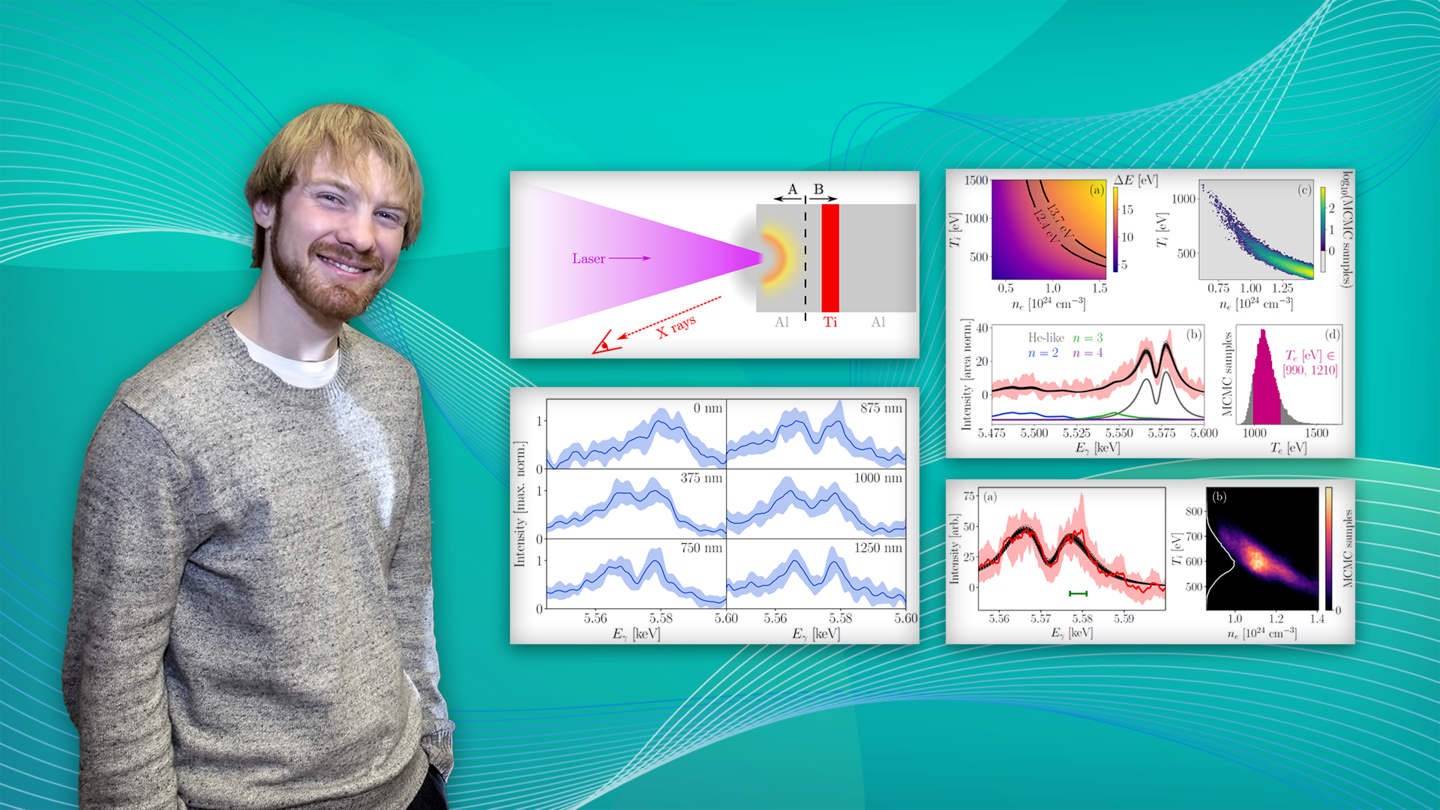Unusual laser-produced high-energy-density (HED) plasmas, similar to those seen in nuclear explosions and stars, could shed light on events occurring all over the universe.
 Physicist Brian Kraus and figures from his paper. (Image Credit: by Elle Starkman/PPPL Office of Communications; collage by Kiran Sudarsanan.)
Physicist Brian Kraus and figures from his paper. (Image Credit: by Elle Starkman/PPPL Office of Communications; collage by Kiran Sudarsanan.)
Physicists at the U.S. Department of Energy’s (DOE) Princeton Plasma Physics Laboratory (PPPL) have found a new approach to quantify and understand these plasmas, among the most unusual states of matter ever created on Earth. Better understanding could offer advantages ranging from perfecting the high-density plasmas in inertial confinement fusion experiments to improved understanding of processes in all areas of the universe.
A Billion Times Denser
HED plasmas are a billion times denser compared to those that power fusion reactions in tokamaks, doughnut-shaped magnetic fusion facilities such as the National Spherical Torus Experiment-Upgrade (NSTX-U) at PPPL.
Everything functions very differently in HED plasmas. We need to better understand how physics works at these very high densities, but clarifying measurements have been difficult up until now.
Brian Kraus, Study Lead Author and Physicist, PPPL
Details of the study, such as the description of the measurement techniques, can be found in the journal Physical Review Letters.
Plasma consists of 99% of the visible universe and comprises free-floating electrons, ions or atomic nuclei. HED plasmas are so dense they are almost solid, in contrast to the gaseous state of tokamak plasmas, forming conditions that physicists are keen to investigate.
Kraus created HED plasma by targeting ultra-high-intensity lasers at thin strips of titanium foil in the Laboratory for Advanced Lasers and Extreme Photonics at Colorado State University. He and his colleagues then used advanced computer codes to examine the high-resolution spectral data that an x-ray diagnostic recorded from the plasma, which zoomed into existence for only trillionths of a second.
The HED plasmas altered the x-ray lines by widening and shifting them to lower energies, Kraus said. “Together these effects let us measure both the plasma density and the ion temperature, which had never been done before. These measurements are very difficult to obtain otherwise in such dense plasmas.”
The study exposed core aspects of the plasmas that had not been formerly known. For example, the investigation discovered that the temperature of electrons and ions were not the same, as had been believed in such plasmas, and the ions were considerably cooler. “It turns out that some approximations that people have been making don’t fit the data that we saw,” Kraus said.
Supervising the path-setting discoveries was Philip Efthimion, Kraus’s thesis adviser who heads the Plasma Science & Technology Department at PPPL and was a co-author of the paper.
“Phil really guided me in planning for experiments and choosing which data analyses to pursue,” said Kraus. He received his doctorate from Princeton University in June and was named a staff researcher subsequently.
“Very Special”
The results in Brian’s thesis are very special. Brian’s ability to understand the X-ray line broadening resulted in accurate measurements of the electron and ion temperatures, simultaneously. It allowed us to conclude that the electrons and ions are not in equilibrium.
Philip Efthimion, Study Co-Author and Head of Plasma Science and Technology Department, PPPL
“This is the first time this situation has been observed in plasma near solid density. Brian mastered many research tools to complete this work. Observing and understanding new phenomena is what truly excites scientists,” Efthimion added.
The experiment at Colorado State was facilitated by LaserNetUS, a new group of laser facilities set up by the Department of Energy. The published measurements were made as part of the program’s first experimental cycle by Kraus.
LaserNetUS is transforming the landscape of laser science in the U.S. by expanding access to high-quality laser facilities. LaserNetUS provided us not just the runtime, but an opportunity to collaborate with great scientists outside of PPPL.
Brian Kraus, Study Lead Author and Physicist, PPPL
Kraus had taken part in the forerunner of the DOE Science Undergraduate Laboratory Internship (SULI) program and gained insight into plasma physics during the week-long course that PPPL provided with the program.
“I would never have heard about plasma until that course,” Kraus said. He then did his internship at the DIII-D National Fusion Facility that General Atomics operates for the DOE in San Diego, California. “That convinced me that this is an area of physics that has pretty direct world-wide importance for potentially solving fusion and having clean power available for everyone,” he said.
Kraus currently is setting up a high-speed camera to capture the evolution of laser-generated HED plasmas at Colorado State.
We’re doing the same experiments this time but basically with a new camera that can see in time. It’s very hard to make a movie when you want to see things that are happening in trillionths of seconds, so it warrants new experiments to set that camera up and see what we can learn.
Brian Kraus, Study Lead Author and Physicist, PPPL
Researchers also are creating “advanced codes without approximations that could enable complete modeling of HED plasmas,” Kraus said. Applying such codes to perform the analysis that PPPL has shown could become “broadly applicable for diagnosing hot plasmas near solid density,” he said.
This study received support from the DOE Office of Science. Co-authors include physicists at PPPL, Sandia National Laboratory, Colorado State University and the University of Nevada, Reno.
Journal Reference:
Kraus, B.F., et al. (2021) Solid-Density Ion Temperature from Redshifted and Double-Peaked Stark Line Shapes. Physical Review Letters. doi.org/10.1103/PhysRevLett.127.205001.